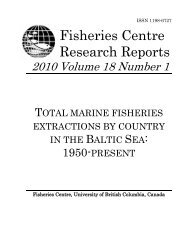Trends in GlobAl MArine Fisheries - Sea Around Us Project
Trends in GlobAl MArine Fisheries - Sea Around Us Project
Trends in GlobAl MArine Fisheries - Sea Around Us Project
You also want an ePaper? Increase the reach of your titles
YUMPU automatically turns print PDFs into web optimized ePapers that Google loves.
74<br />
and bluef<strong>in</strong> tuna have high trophic levels, rang<strong>in</strong>g<br />
from 3.5 to 4.5 (see references <strong>in</strong> Table 1,<br />
and www.fishbase.org). When fed only vegetable<br />
matter, e.g. soy meal, salmon do not grow well,<br />
and end up look<strong>in</strong>g and tast<strong>in</strong>g like tofu. As for<br />
tuna, there is no po<strong>in</strong>t even try<strong>in</strong>g to feed them<br />
with anyth<strong>in</strong>g but fish. What this implies is that<br />
the more aquaculture B is undertaken, the less<br />
cheap yet healthy (high omega-3 oils) fish such<br />
as sard<strong>in</strong>e, herr<strong>in</strong>g, mackerel and anchovies there<br />
will be for humans to buy and eat. Aquaculture<br />
B does not reduce the pressure on wild fish<br />
stocks: it <strong>in</strong>creases it (Naylor et al. 2000). It has<br />
led to massive imports, by developed countries,<br />
where Aquaculture B predom<strong>in</strong>ates, of fish-meal<br />
from fishes caught and ground up <strong>in</strong> develop<strong>in</strong>g<br />
countries, thus exacerbat<strong>in</strong>g fish<strong>in</strong>g pressures<br />
<strong>in</strong> these countries. We will not elaborate on the<br />
coastal pollution and diseases emanat<strong>in</strong>g from<br />
the uneaten food and feces of these mar<strong>in</strong>e feedlot<br />
operations, which responsible practitioners see<br />
as a major constra<strong>in</strong>t to the development of the<br />
<strong>in</strong>dustry (New 2002).<br />
One reason why the practitioners of aquaculture<br />
B can get away with all this is that the public<br />
at large assumes their operations to be similar<br />
to those of Aquaculture A, and that they add to<br />
the global fish supply. The cont<strong>in</strong>ued growth of<br />
Aquaculture B will be more difficult once the<br />
dist<strong>in</strong>ction becomes clear to the public.<br />
There is still time for fisheries, but only if they<br />
are re<strong>in</strong>vented not as the source of an endlessly<br />
grow<strong>in</strong>g supply of fish for an endlessly grow<strong>in</strong>g<br />
human population, but as provider of a healthy<br />
complement to predom<strong>in</strong>antly gra<strong>in</strong>-based diets.<br />
Particularly, fisheries cannot rema<strong>in</strong> a free-for-all<br />
for pillag<strong>in</strong>g distant water fleets; they can however,<br />
become a regular source of <strong>in</strong>come for communities<br />
whose members act <strong>in</strong> accord with the<br />
f<strong>in</strong>ite nature of mar<strong>in</strong>e resources (Pitcher 2001).<br />
Two key elements of such re<strong>in</strong>vented fisheries<br />
will be their considerably smaller size, and their<br />
reliance on fish biomass be<strong>in</strong>g exported from<br />
numerous, large mar<strong>in</strong>e reserves, the protected<br />
ocean areas that we must establish and enforce if<br />
we are to allow mar<strong>in</strong>e ecosystems and the species<br />
there<strong>in</strong> to rebuild some of their past abundance,<br />
and to share this with us.<br />
FISH, SUSTAINABILITY AND DEVELOPMENT





![Nacion.com, San José, Costa Rica [Nacionales] - Sea Around Us ...](https://img.yumpu.com/26166123/1/190x245/nacioncom-san-josac-costa-rica-nacionales-sea-around-us-.jpg?quality=85)










